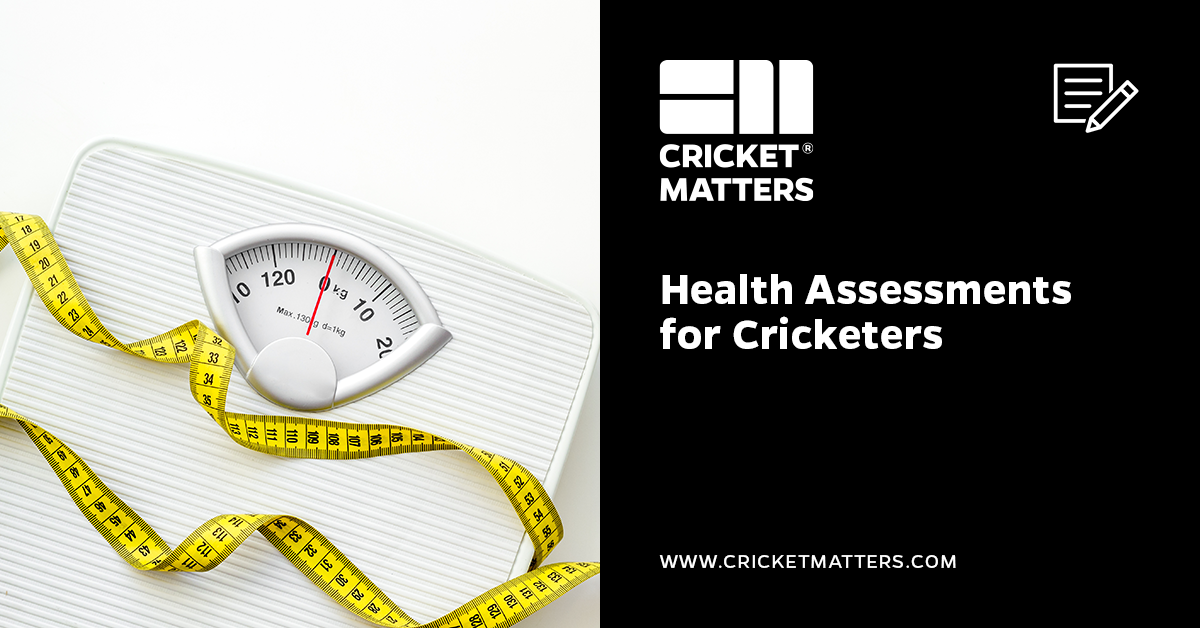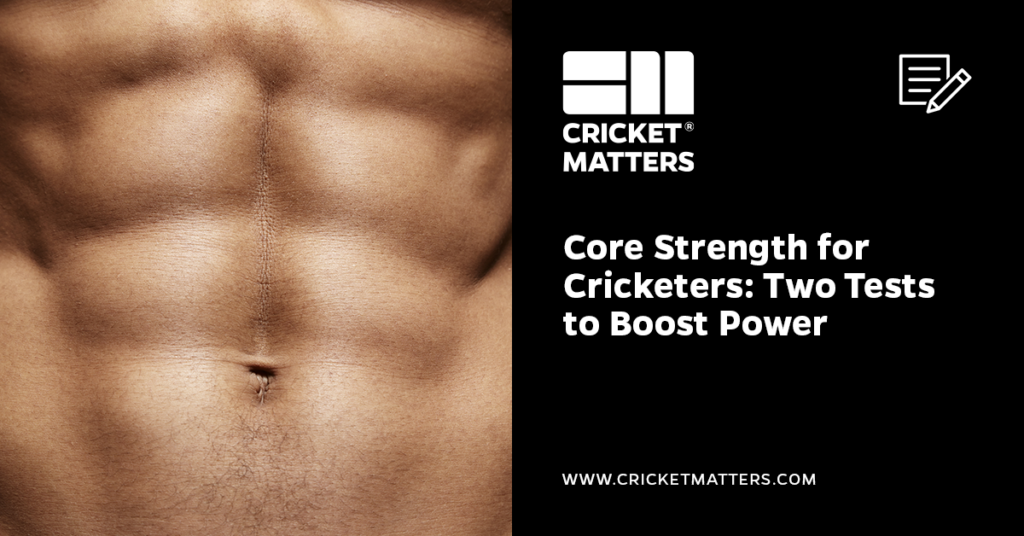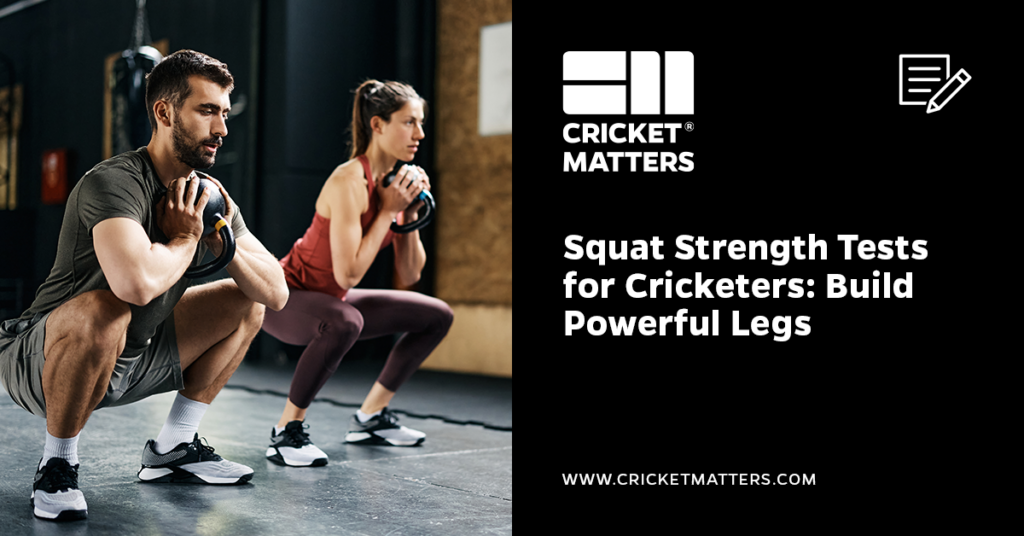
I hope you enjoy reading this blog post.
James Breese, Cricket Matters FounderIf you need my help with cricket coaching, strength and conditioning, injury rehab, or nutrition, click here.
The first thing we do when we start working with new cricketers is perform a series of health assessments.
Why?
Because without good health, you have nothing.
We need to uncover the truth about your health and fitness, and we must do so without bias.
Sometimes, though, the truth hurts. The truth about your fitness can be frightening.
It makes you take a long, hard, uncomfortable look at yourself.
So, in this blog, I will share our entire system of health assessments for cricketers.
Table of Contents
Introduction
Most people are unwilling or unable to confront their fears, so they become great dreamers but poor action-takers.
This is why many aspiring cricketers fail to stick to long-term health and fitness plans to support their technical development.
The truth may hurt, but embracing it gives you a clear path forward to plan well and succeed. It gives you the best platform possible to keep you pushing towards the goals you set.
Truth is the catalyst for your athletic success.
Our assessments establish the truth and determine your starting level, which, more often than not, can be a long way from where you think it is.
Assessments and truth are the foundation for any successful health and fitness plan. At Cricket Matters, our plans always start with health.
According to the World Health Organization, health is:
A resource for everyday life, not the objective of living. Health is a positive concept emphasising social and personal resources, as
well as physical capacities.
In short, a healthy lifestyle provides the means to lead a full life.
A healthy athlete is a happy athlete who usually performs to a higher level.
At Cricket Matters, we focus on two facets of health: Mental and physical.
Other facets of health, such as spiritual, emotional, and financial, all play an important role in our lives and are linked to lower stress levels and mental and physical well-being.
However, these tend to be beyond the scope of our practice as fitness professionals.
In our professional experience, baseline mental and physical health affects everything our cricketers do.
Health has a direct correlation to improved fitness and performance.
The healthier the athlete, the better we can improve his or her fitness – up to a point, because elite fitness does not always mean healthy!
When we assess health, we highly recommend that our athletes start by seeing a medical professional for a routine physical.
The more you know about your own body, the better.
Once you have the all-clear, we’ll assess the following areas:
- Body
- Lifestyle
- Mortality
- Breathing
Health Assessments for Cricketers

Before we explain why we do these assessments, here’s a breakdown of our health assessments.
We use the traffic light system of red, amber, and green to assess performance:
- Red = Dysfunction
- Amber = Proceed with caution
- Green = Optimal
Test 1: Breathing
| Test | Directions | Standards |
| Breath Hold Test | 1. Breathe in and breathe out naturally. At the end of the exhale, hold your breath breath by plugging your nose. 2. Hold your breath until you desire to breathe or experience involuntary muscle activity from the diaphragm or other breathing muscles. 3. Start a timer as soon as you hold your breath, and stop when you release your nose or you feel the first sign of muscle activity in the diaphragm or neck. **Note: It’s not how long you can hold your breath; it’s held until the first sign to breathe. | Red: < 25 Seconds Yellow: 26 – 35 Seconds Green: > 35 Seconds |
Test 2: Heart Health
| Test | Directions | Standards |
| Resting Heart Rate (RHR) | Check your pulse at your wrist by placing two fingers between the bone and the tendon over your radial artery located on the thumb side of your wrist. When you feel your pulse, count the beats in 15 seconds. Multiply this number by four to calculate your beats per minute. **Note: Perform this test before you get out of bed in the morning and before caffeine. | Red: ≥ 70bpm Amber: ≥ 55bpm < 70bpm Green: < 55bpm |
| Active Recovery Heart Rate (ARHR) | Perform three minutes of continuous step-ups. Essentials needed to perform the test: – 12-inch tall step or box – Stopwatch or timer – Metronome Test Procedure: Set the metronome to 96 beats per minute and stand facing your step. When ready, start the stopwatch or timer and begin stepping on and off the step to the metronome beat, following a cadence of up, up, down, down. Continue for three minutes. Stop immediately when you reach three minutes and sit down on your step. Perform a manual pulse reading, count the number of beats for 30 seconds, then multiply by two. | Red: ≥ 115 bpm Amber: ≥ 90bpm < 115bpm Green: < 90bpm |
Test 3: Lifestyle
| Test | Directions | Standards |
| Monthly Sleep Average | Using your health tracking app as a reference point, please record your daily sleep average from the PREVIOUS month (30 days). You can find this in your Fitbit or Apple Health data by clicking Sleep Analysis. | Red: < 6 hours Amber: ≥ 6 hours < 7 hours Green: ≥ 7 hours |
| Monthly Step Average | Using your health tracking app as a reference, please record your daily step average from the PREVIOUS month (30 days). You can find this in your Fitbit or Apple Health data simply by clicking Steps. | Red: < 7,000 steps Amber: ≥ 7,000 < 10,000 steps Green: ≥ 10,000 steps |
Test 4: Body Composition
| Test | Directions | Standards |
| Weight | Use a smart scale in the morning after you empty your bladder and/or have any bowel movements, wearing as little clothing as possible, and before you have anything to eat or drink. | Men: Height (cm) – 100 = Athletic Weight (kg) ± 5kg Women: Height (cm) – 107 = Athletic Weight (kg) ± 5kg It is best used in conjunction with all other testing measures. |
| BMI | Using your health tracking app as a reference, please record your daily step average from the PREVIOUS month (30 days). You can find this in your Fitbit or Apple Health data simply by clicking Steps. | Red: ≥ 30 Amber: ≥ 25 < 30 Green: < 25 This controversial method is best used in conjunction with all other testing measures. |
| Body Fat Percentage | Record your body fat percentage using your smart scale as a reference. Alternatively, use the U.S. Navy Body Fat Calculator. | Men: Red: ≥ 20%. Amber: ≥ 15% < 20% Green: ≥ 6% < 15% Women: Red: ≥ 30% Amber: ≥ 25% < 30% Green: ≥ 16% < 25% |
| Waist Circumference | Measure the circumference of your waist. Use a measuring tape to circle your waist at your natural waistline, located above your belly button and below your rib cage. [If you bend to the side, the crease that forms is your natural waistline.] Don’t suck in your stomach, or you’ll get a false measurement. | Men: < 40 inches Women: < 35 inches |
| Waist: Height Ratio | Please take your waist size (either in centimetres or inches) and divide it by your height. For example: centimeters= 79/173 (waist/height) = 0.46 inches = 38/71 (waist/height) = 0.54 | Red: ≥ 0.6 Amber: ≥ 0.5 < 0.6 Green: < 0.5 |
Test 5: Longevity
| Test | Directions | Standards |
| Sit and Rise Test | Without worrying about the movement speed, sit on the floor and rise to your feet, using the minimum support you believe is needed. A maximum of 10 points is possible, five for sitting and five for rising without support. Each support used (hand, forearm, knee, side of leg, or hand on the knee) removes one point. Participants may also lose half a point for an unsteady performance. | Red: < 8 Amber: ≥ 8 < 9 Green: > 9 |
Why We Assess Breathing First

Better breathing is the gateway to a whole new level of health and wellness.
Better breathing improves oxygenation of the body’s heart, brain, and other working muscles.
It helps your body work more efficiently, creating and setting the conditions for successful athletic performance and even fat loss.
Most people in Western society are terrible breathers. They are what we call mouth breathers.
Mouth breathing can reduce the amount of oxygen that reaches vital organs and muscles, thus decreasing one’s standard of living, quality of life, and ability to perform physically and lose body fat.
Our breathing assessment tests your ability to breathe nasally and your tolerance to carbon dioxide.
How We Assess Mortality
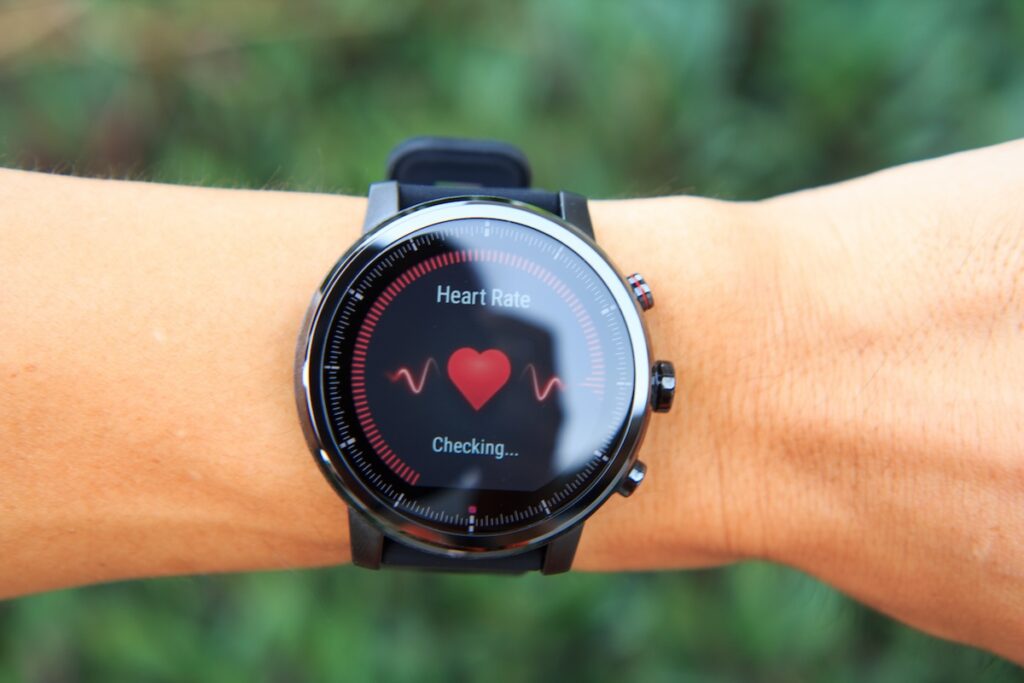
I know this is depressing, but it’s an important topic to discuss for the older cricketers we work with.
Assessing mortality is a complex task, and we must once again remain focused on our roles as fitness professionals and only do what’s safe and within our ability to monitor.
For our assessments, we use the results of four tests:
- Resting Heart Rate (RHR)
- Active Recovery Heart Rate (ARHR)
- Sit and Rise Test
- Waist-to-Height Ratio
Resting Heart Rate (RHR)
A 2013 study in the journal Heart tracked the cardiovascular health of about 3,000 men for 16 years and found that a high RHR was linked with lower physical fitness and higher blood pressure, body weight, and levels of circulating blood fats.
The researchers also discovered that the higher a person’s RHR, the greater the risk of premature death.
Specifically, an RHR between 81 and 90 doubled the chance of death, while an RHR above 90 tripled it.
RHR is one of the easiest and possibly most effective ways to gauge your health. It can be done in 30 seconds with two fingers.
It measures the number of heartbeats per minute while you’re at rest, providing a real-time snapshot of how your heart muscle is functioning.
Active Recovery Heart Rate (ARHR)
In addition to the RHR, we measure your ARHR. It’s a great way to measure your cardiac efficiency as it tells us the speed at which your heart rate returns to normal after exercise.
Like the RHR, it can indicate physical cardiac condition and the risk of cardiovascular disease.
According to the New England Journal of Medicine, people whose heart rate recovery time is longer are at a higher risk of death than people with shorter recovery times, regardless of physical condition or other risk factors.
People in better cardiovascular condition tend to have lower heart rates during peak exercise and can return to their RHR more quickly after physical activity.
We use this test to screen for potential complications and record a baseline to see how it improves over time with your new training program.
The Sit and Rise Test
The Sit and Rise test evaluates a person’s ability to sit and rise from the floor.
It has proven to be a very accurate predictor of mortality risk. Initially developed in the 1990s, one study of subjects between the ages of 51 and 80 found that those who had the lowest scores were five to six times more likely to die within the study period (about six years) than those in the group with the highest scores.
Dr Claudio Gil Araújo, who published the study, said:
It is well known that aerobic fitness is strongly related to survival, but our study also shows that maintaining high levels of body flexibility, muscle strength, power-to-body weight ratio, and coordination are not only good for performing daily activities but have a favorable influence on life expectancy.
We tend to agree and consider this one of our most important assessments. For both young AND older cricketers.
The Waist-to-Height ratio Test
Individuals who are either overweight or obese are at higher risk of developing conditions such as heart disease and type 2 diabetes as well as general inflammation.
According to the National Heart, Lung, and Blood Institute (NHLBI), people of moderate weight are also at greater risk of developing these conditions if their waist circumference increases.
Why We Assess Basic Body Composition

In a study published by the British Medical Journal, the majority of obese people in Britain wouldn’t describe themselves as “very overweight.”
The study found that only 10 percent of clinically obese people admitted they had a weight problem.
This study shows that people may view themselves as healthy when that might not happen.
We see this time and time again with cricketers.
Fat loss is important; collectively, most industrialized societies are likely to be over-fat.
The United States, Mexico, and the United Kingdom are the top three most obese nations in the world with 31 percent, 24 percent, and 23 percent of the population older than 15 having a body mass index (BMI) greater than 30.
[BMI measures body fat based on height and weight; a healthy BMI is between 18.5 and 24.9.]
Being over-fat isn’t just an aesthetic problem. Excess body fat can negatively affect nearly every part of your life, causing:
- decreased mobility
- poorer emotional health and self-esteem
- increased risk of organ failure
- poorer circulatory health
- increased risk of heart disease
- increased risk of stress fractures
- increased risk of strokes
- increased risk of cancers
- decreased sexual and reproductive health
The bottom line is that excess body fat worsens health and athletic performance.
Lower body fat is advantageous for cricketeres as extra fat weight adds drag and additional resistance that must be overcome.
Unfortunately, most cricketers are unaware of this issue and are unlikely to identify with health messages about weight.
We assess so openly here: to start the conversation and find our starting point. In reality, most cricketers carry excessive fat.
How We Assess Body Composition
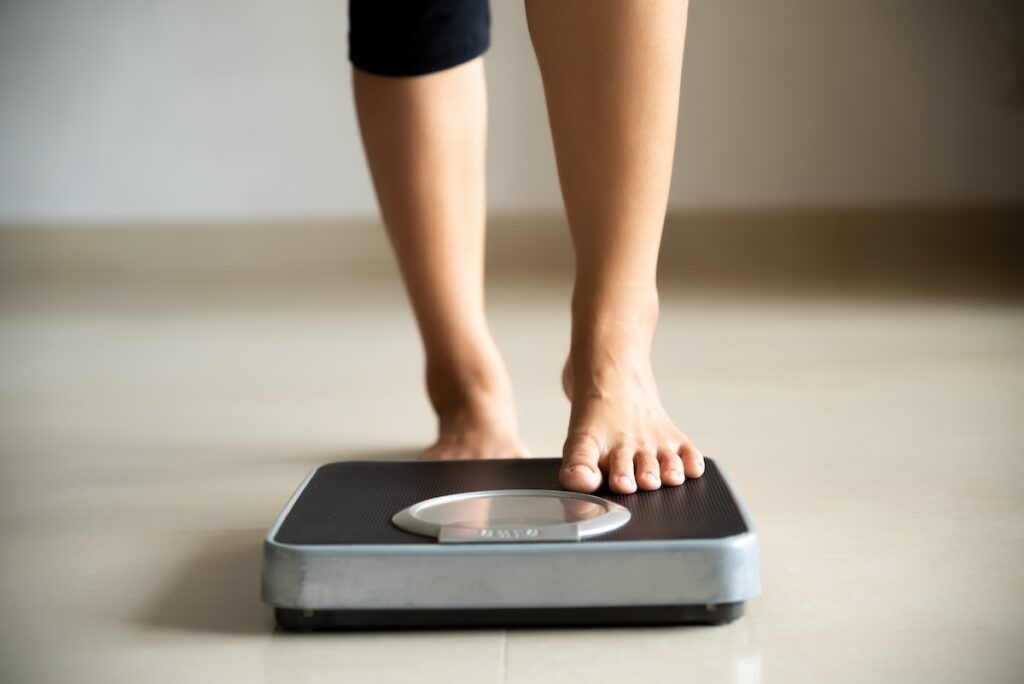
When it comes to body composition, here’s what we assess:
- Weight
- BMI
- Body Fat Percentage
If you haven’t read our blog The Perfect Height and Weight of Cricket Players and recommend doing so to learn more about what is performance weight for cricketers and the secrets you can learn from the elite.
This breaks down our formula for calculating performance weight for cricketers in detail.
In an ideal world, everyone would use a DEXA Scan or the InBody system to measure these basic metrics; however, this is not physically, practically, or financially viable for most.
We’ve found that the Withings Body+ is a great in-home alternative.
It’s not perfect, but if people follow the same protocol each time they measure, they get a better-than-average baseline reading.
Here’s our exact advice:
Use your smart scale in the morning after you empty your bladder and/ or have any bowel movements, wearing as little clothing as possible, and before you have anything to eat or drink.
In addition to these metrics, we ask for a client’s waist measurement to find their waist-to-height ratio.
Determining your BMI at home is not perfect, so the waist-to-height ratio often gives us a truer picture of overall health.
For those unfamiliar with this measurement, your waist-to-height ratio is calculated by dividing waist size by height.
If your waist measurement is less than half your height, you’re likely not at risk for obesity-related disease.
Going one step further, we also collect posture photos (front and sides) to ensure visual readings are kept.
Once we have all these measurements, we will have your full body composition picture.
Further Reading
Assessing Lifestyle
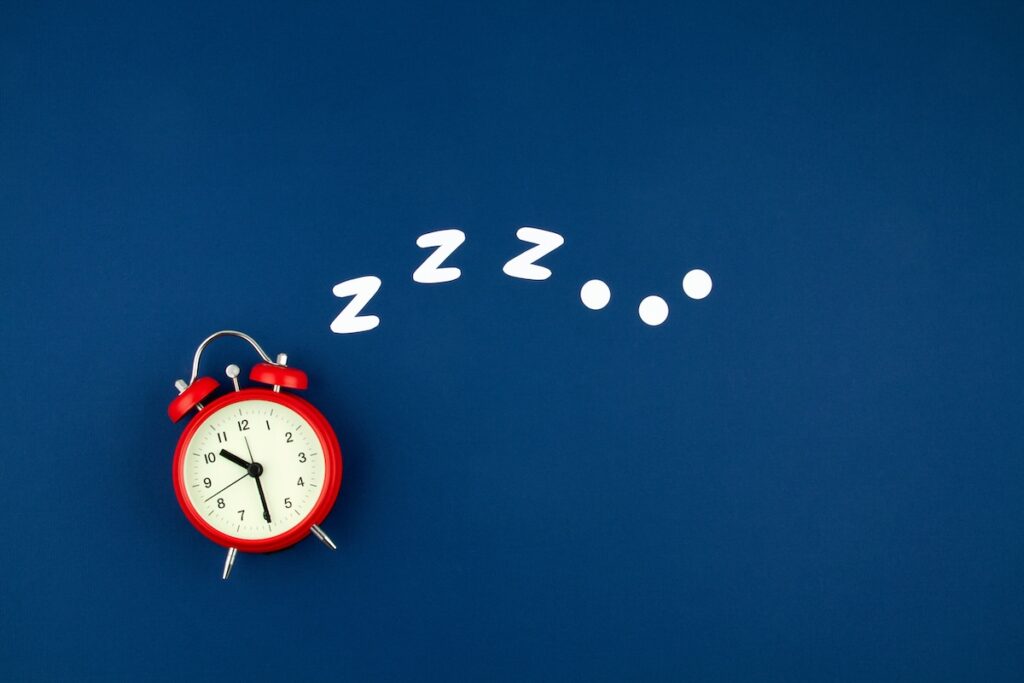
Assessing lifestyle is complex, as hundreds of different aspects are available to measure.
For our health and fitness assessments, we’ve narrowed it down to just two areas:
- Daily Steps (monthly average)
- Nightly Sleep Time (monthly average)
These two areas alone can give us valuable insight into how active or sedentary you are and how you manage your day-to-day stress levels.
The importance of an active lifestyle paired with quality cannot be overestimated, which is why it’s part of our initial health assessments.
Research proves inactive, sedentary lifestyles and poor sleep levels significantly negatively impact overall health and athletic performance.
That’s why we ensure that everybody follows Walk, Water, Sleep (WWS) and the Triple Seven Rule in conjunction with their individualised training programs.
[These two concepts require everyday athletes to walk 7,000 steps, drink seven glasses of water each day, and sleep seven hours each night.]
Most cricketers who are unfit, more often than not, have less than 5,000 daily steps to their name and sleep considerably less than seven hours a night.
Most amateur cricketers perform poorly on these assessments, a good reminder that health is about more than exercise.
[Case Study] How We Interpret This Data
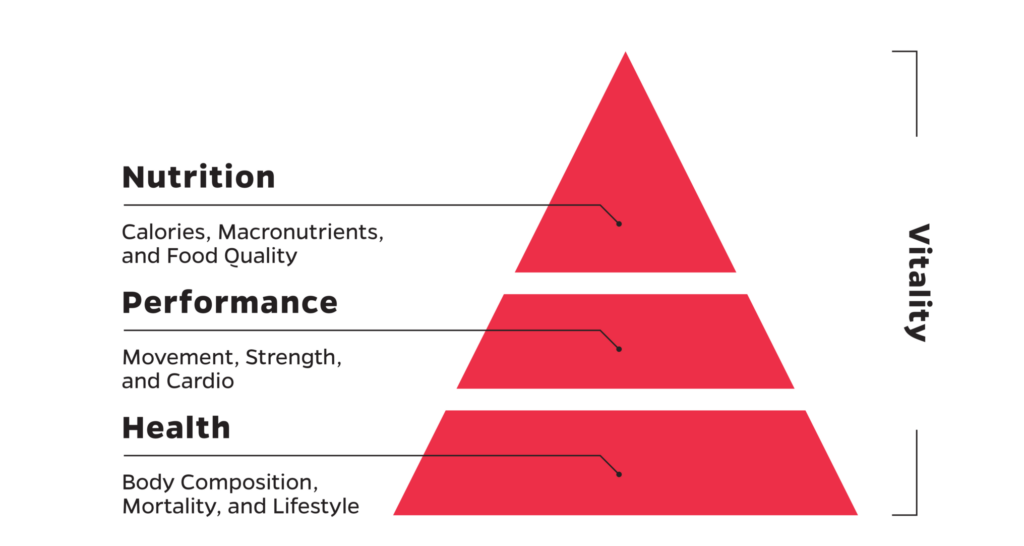
Data is only as good as how you interpret it.
If you want to learn more about our athletic performance model for cricketers, I suggest reading The Cricket Performance Pyramid: Athlete Development System for Cricketers and The 10 Components of Fitness for Cricket.
However, in practical terms, this is what we do with this data when we collect it from our athletes.
In short, we’ve created an algorithm and scoring system that allows us to gauge and score each athlete quickly.
This is what health looks like with one of our current athletes in conjunction with the other four quadrants of movement, strength, and cardio.
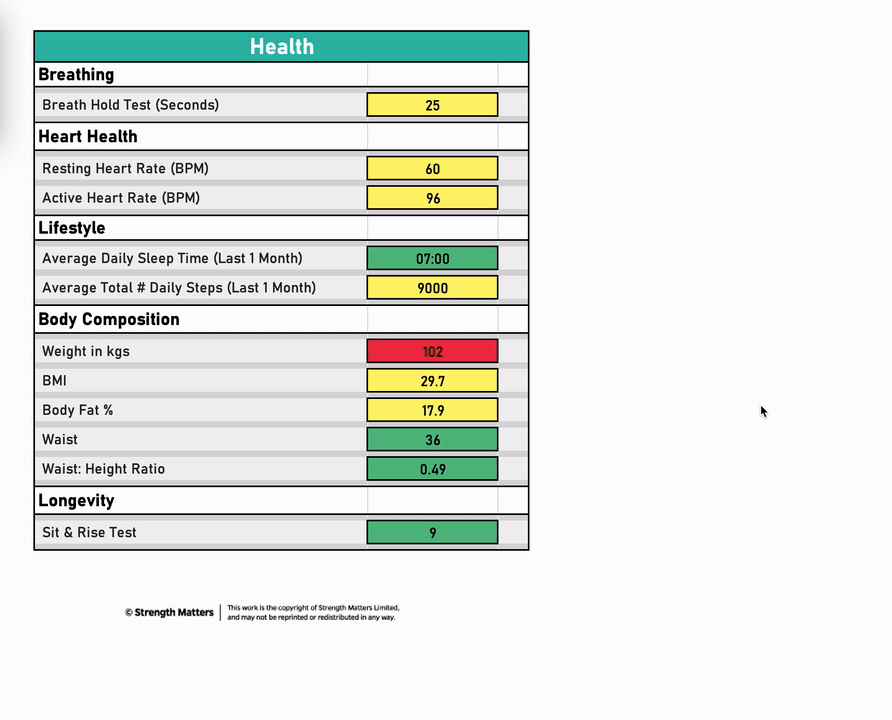
If you’re interested in our movement, strength and cardio assessments. Don’t worry. We’ll share more info about them in future posts.
However, here’s what you need to know about this cricketer who aspires to a professional contract.
Athlete Background
- Age: 19
- Type: Fast Bowler
Main Areas of Concern
- Bodyweight (Showing in Red). Far above the norm of professional, elite fast bowlers
- BMI
- Body Fat %
We know that this athlete is a fat loss client. If we did nothing with him other than help him lose weight and body fat, he’d become a better cricketer.
It’s clear and concise, and both the athlete and coach know what our main focus should be.
That’s how we use this data to create better cricketer training programs.
Final Thoughts: Health Assessments for Cricketers
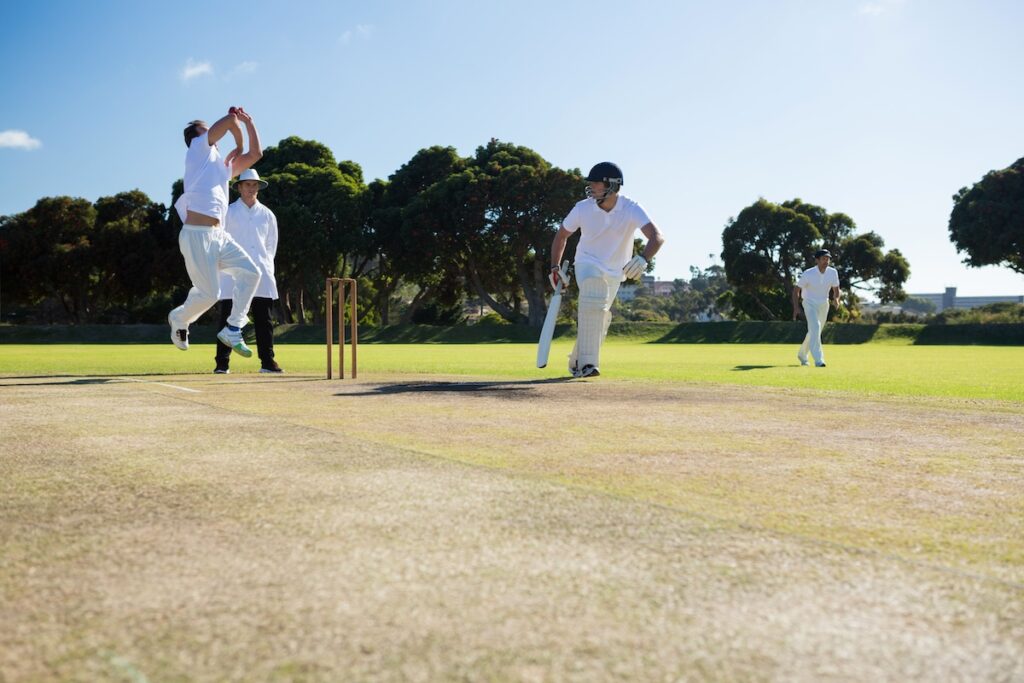
Hopefully, this has given you a better insight into how we assess health for cricketers and why we feel it’s so important.
It forms the base of everything else we do, and no matter how athletic you want to become, you’ll always be swimming against the tide if you don’t take responsibility for your health.
In our experience, healthy cricketers are better cricketers, and the simplest way to improve match-day performance is to address your health issues.
If you have any questions about our assessments system for cricketers or want to take the assessments yourself, you can book a FREE Strategy Call with me to see if it’s the right option.
Further Reading
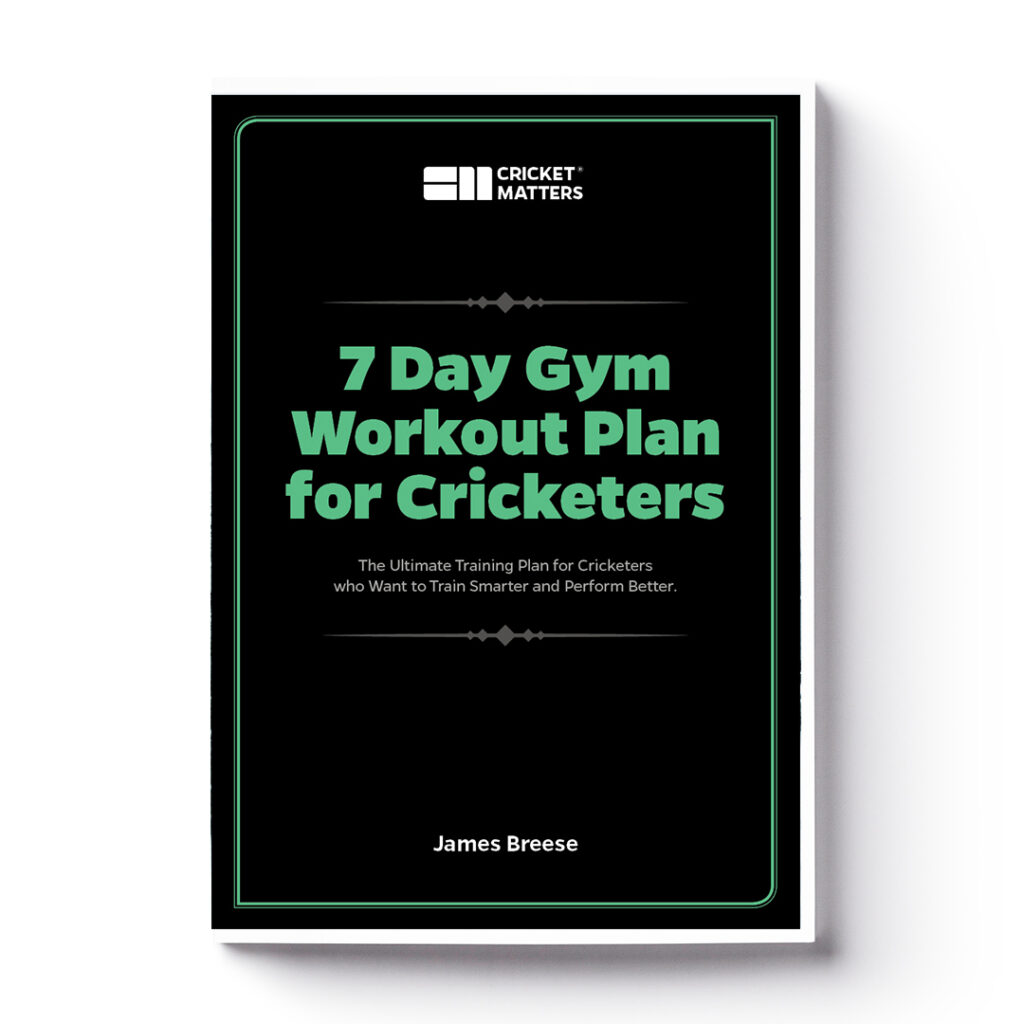
Have You Downloaded Our FREE 7-Day Gym Workout Plan?
Grab your complete step-by-step 7-day gym workout plan for cricketers today. There will be no more Guesswork. Just follow the plan and get results.
FAQs
What Are the Key Health Assessments for Cricketers?
Key health assessments for cricketers include breathing assessments to evaluate respiratory efficiency, heart health tests like ECGs to ensure cardiovascular fitness, and lifestyle factor evaluations, which consider diet, sleep, and stress levels. Body composition analysis measures muscle mass, fat percentage, and overall weight to tailor fitness programs. The Sit and Rise Test assesses flexibility, strength, and mobility, which are essential for cricket-specific movements. Starting health assessments with a medical professional ensures accuracy and safety.
Why Is Breathing Assessment Important for Cricketers?
Breathing assessments are crucial for cricketers as they evaluate respiratory efficiency, ensuring optimal oxygen intake and utilization. This is vital for endurance, stamina, and overall performance, particularly during prolonged matches and intense training sessions. Identifying any breathing limitations early helps implement corrective measures, enhancing overall fitness and reducing the risk of respiratory-related performance issues.
How Do You Measure Heart Health in Cricketers?
Electrocardiograms (ECGs) and stress tests measure heart health in cricketers. These assessments monitor heart rate, rhythm, and overall cardiovascular function, identifying potential issues like arrhythmias or other heart conditions. Regular heart health monitoring is essential to ensure cricketers maintain peak cardiovascular fitness, which is crucial for sustained high performance and endurance on the field.
How Is Body Composition Evaluated in Cricketers?
Body composition in cricketers is evaluated through muscle mass, fat percentage, and overall body weight measurements. Techniques like skinfold measurements, bioelectrical impedance analysis, and dual-energy X-ray absorptiometry (DEXA) scans are commonly used. Understanding body composition helps design custom fitness and nutrition programs, ensuring cricketers maintain an optimal balance of muscle and fat for absolute performance.
How Do Health Assessments Improve Cricket Performance?
Health assessments improve cricket performance by identifying and addressing physical and physiological needs specific to each player. Regular assessments of breathing, heart health, lifestyle factors, and body composition provide crucial data to optimize training regimens, nutrition plans, and recovery strategies. This holistic approach ensures cricketers are physically fit, resilient, and capable of performing at their best, reducing the risk of injuries and enhancing overall performance.

